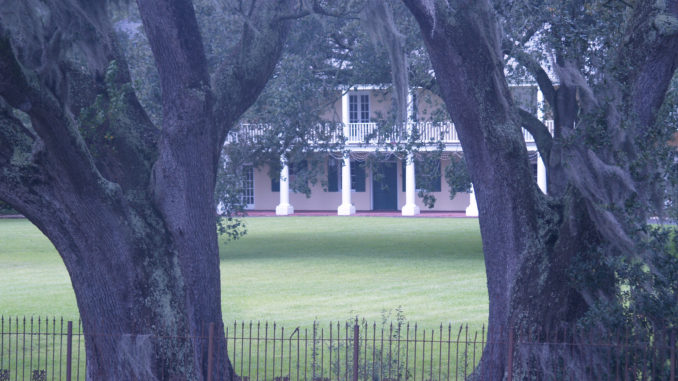
With Halloween approaching, residents and visitors from outside the parish will make their way to the Destrehan and Ormond plantations, hopeful that they might catch sight of one of the mansions’ supposed ghosts.
Like most old homes, the history of both plantations is filled with mystery and tragedy.
The History of Destrehan Plantation
Established in 1787, the Destrehan Plantation is the oldest documented plantation home in the lower Mississippi Valley.
For three years, Charles Paquet, a free mullato who was contracted by Robin deLogny, worked to build the French Colonial style plantation. When the home was finished, deLogny wouldn’t have much time to enjoy it, living there for only two years before his death in 1792.
In 1810, deLogny’s daughter Celeste and husband Jean Noel d’Estrehan purchased the plantation and added two wings to accommodate 14 children.
Descendants of the family owned the property until the early 1900s. One of them, Elenore Destrehan, married a man named Stephen Henderson whose ghost has allegedly been sighted at the plantation.
Henderson was a friend of Jean Lafitte, and while Lafitte never visited the home, there is a legend that he buried treasure somewhere on the plantation.
When the house was abandoned in 1958, it was broken into by vandals and treasure hunters searching for the pirate’s bounty.
The ghost on the stairs
For many years, employees, their families and visitors have reported seeing ghosts on the property. Henderson’s ghost is the most sighted. He was only married to Elenore a year before she died, and was so devastated, that he died a few years later. Both are now buried in a cemetery near the plantation.
One of those who reported seeing Henderson was Annette Roper, whose parents were employed by the plantation in 1984. Roper said that she was reading in her bed when she saw a transparent form that appeared to be sitting in a chair. When Roper tried to touch the figure, she says her hand went through the misty shape.
Roper said she saw the figure two more times. One day she saw it in a second-floor window, and the next time she observed it walking across the driveway.
During the Destrehan Plantation Spring Festival in June of 2006, Australian mystic Victoria Maison said she saw a ghost on the stairway in the back of the plantation. This alleged ghost was also captured on film. The photo was at the on-site gift store until the owner decided to take it back.
Because of these supposed sightings, the plantation does get its fair share of visitors during Halloween, Executive Director Nancy Robert said.
“We do have legends of ghost appearing here and there have been pictures where people believe they see something strange, but it’s nothing that we can really prove,” Robert said. “Just like all plantations, there are some people that believe they can feel a presence at places that have such a long history.”
Robert said that the plantation also gets visitors who are fans of Anne Rice and want to see the area where a small part of the movie “Interview with the Vampire” was filmed.
“We do get fans of Anne Rice and people who visit because there are stories that go along with all plantations,” Robert said. “This is a great time to visit because the grounds are at their best and we invite people to come take a tour of the plantation and see for themselves.”
Destrehan Plantation offers tours daily from 9 a.m. until 4 p.m. The cost is $15 for adults and $5 for those between the ages of 6-16.
The History of Ormond Plantation
In the early 1780s, Pierre d’Trepagnier was awarded a tract of land by Spanish Governor Don Bernardo deGalvez in recognition of his service in subduing the British at Natchez during the American Revolution. The main building was completed shortly before 1790 and occupied by Mr. and Mrs. d’Trepagnier and their children. D’Trepagnier soon began growing indigo – and then sugar cane – and the plantation began to prosper.
Owners meet tragic, mysterious ends
Ten years after the home was finished, it was the site of a slave uprising. According to the Ghost Hunter’s Guide to New Orleans, the leader of the rebellion was eventually caught and punished. While he was being whipped, the slave allegedly laid a curse on the master and the plantation.
The first of the home’s many mysteries began in 1798 when d’Trepagnier was summoned from a family meal by a servant to meet a man dressed as a Spanish official. D’Trepagnier left with the man and was never heard from again.
From 1805 to 1819, Col. Richard Butler owned the plantation. When the yellow fever epidemic arrived in New Orleans, he sold the plantation to his brother-in-law and moved to Mississippi. A year later, Butler and his wife fell victim to the yellow fever.
In 1898, State Senator Basile LaPlace, Jr. bought the plantation, but his time there was short. LaPlace, who had allegedly made enemies with the Ku Klux Klan, was called out into the night and riddled with bullets. LaPlace was then hung in the large oak tree which stands on River Road in front of the plantation home.
Over the years, there have been reported ghost sightings by the staff, according to the Ghost Hunter’s Guide to New Orleans.
Ormond Plantation offers tours from Monday-Friday, excluding lunch hours. The cost of the tour is $7 for adults and $3 for children.




Be the first to comment